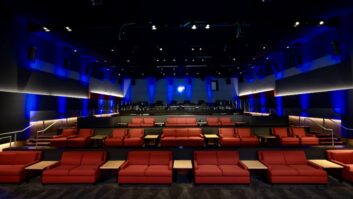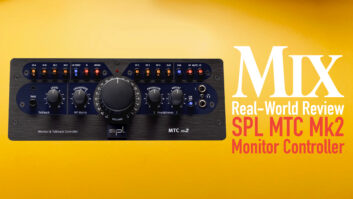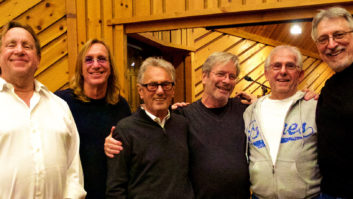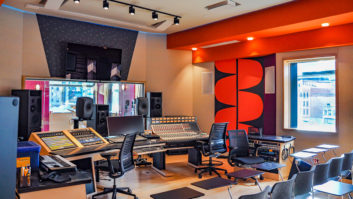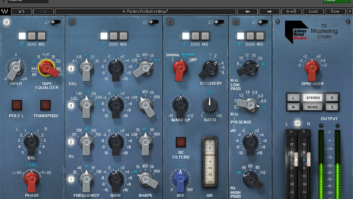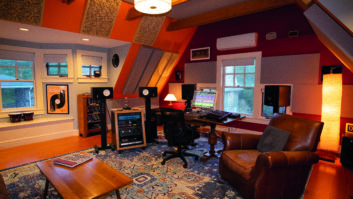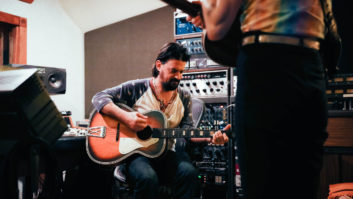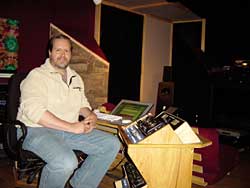
Despite the much-publicized malaise afflicting the record industry in general, these are pretty good times for most mastering engineers. After all, even though major-label rosters have been trimmed, many recording studios are struggling and album sales are down, the sheer number of audio and DVD projects flooding the marketplace — an increasing number of them as independent releases — is still enormous, and competent mastering continues to be viewed as an essential and affordable step in the recording process.
There are some dark clouds gathering, however: Reputable mastering professionals are competing against a growing legion of recording facilities (and sometimes even the musicians themselves) who often use less-than-optimum semi-pro gear. And while we all know that these days one can record a great album on budget gear, the critical detail called for in mastering requires professional tools, often designed expressly for the task, such as top-quality audiophile monitors and EQs offering super-precise increments of adjustment. And perhaps even more insidious to quality-conscious engineers is the widespread, passive acceptance of low-resolution audio experienced through tiny ear buds and mediocre computer speakers. That’s beyond their control, of course — it’s a societal shift toward convenience and portability. All they can do is make sure that the music sounds as good as it can when it leaves their mastering rooms.
Alan Douches
Recently, Mix spoke with four top mastering engineers from different parts of the country — Paul Stubblebine, Andrew Mendelson, Alan Douches and Joe Gastwirt (see “The Featured Four” on opposite page for details) — to find out about some of the issues that affect them these days.
DEMOCRATIZATION OF TECHNOLOGY: GOOD FOR ALL?
Stubblebine starts us out with a little historical perspective: “I started long ago enough that I remember the days when you couldn’t make a record until you convinced a record label you were worth making a record with. The labels had the only studios, and you couldn’t even say, ‘I’ll hire the studio.’ Those days are long gone, obviously. Now anyone with a gold card and access to Guitar Center can have a studio at home and make records, and many of them do. Then the next thing that happened is the home studio revolution spread to mastering. Everybody started thinking, ‘It’s just another program in the computer, or plug-in, or box, and I can do it.’ For better or worse, now everybody says they do mastering, and I suppose they do on some level. The spread of the technology has meant that it can be in anyone’s hands. I’m certainly in favor of anything that puts power in the hands of the artist, but an awful lot of records are being made by people who don’t approach the craft of recording with as much enthusiasm as they do the musical side. And the fact that [mastering] is so widespread now means perhaps the craft is not quite as respected as it was at one time. I regret anything that dilutes the seriousness of the craft.”
“Just like everywhere in the business,” Mendelson notes, “there’s a decentralization going on in mastering, in part because the tools required aren’t the same as they used to be — I mean, you don’t need a lathe anymore, for example, and CD burners have become very affordable. It’s easier than ever to open up a ‘mastering studio.’ There’s been a decentralization of the recording industry in general, and attention to quality has in some instances gone away. It seems as though people are focusing less on, ‘Am I using the best possible burner?’ ‘Am I finding the best dither for this project?’ ‘Am I using the absolute best A-to-D I can to transfer to the digital domain?’ There’s been a shift away from quality in favor of convenience and economizing, but there are still many artists who treat mastering seriously, even at the indie level.
“On a lot of independent projects that were done on a budget — maybe they were made in a bedroom or a garage — they’re looking for some step to take their music to the next level,” he continues. “Certainly top-notch mastering is a great place to accomplish that if you don’t have the budget to go in and mix with the best engineers in the best studios on the best gear. What’s the one step that can take this project to the next level while keeping to a relatively small budget? Mastering can be an economical place to put your money.”
“Purely aside from my own business interest,” adds Douches, “I think it’s really important for an artist to have someone with a fresh perspective viewing their music, someone they respect, because they don’t know where it’s going: Is it only going to be 1,000 sales, or is it going to be 150,000? We’ve had the good fortune of having a couple of indie artists break through, like Ben Folds Five and Sufjan Stevens. We did their first records, and if we didn’t take the care we did with them, who knows what would have happened? I certainly don’t take credit for their success — that’s absurd — but you really have to do whatever you can with every project that comes in, whether they’re big or small. I think indie artists are learning that if they take their career seriously — if they’re going out on tour and will be promoting and marketing their product — good mastering is not a step that should be overlooked.”
“Something that happens with artists who record and mix at home,” Stubblebine says, “is when they walk in my door, if they monitored on a system that isn’t really dialed-in or full-range, sometimes they are a little surprised at what’s actually there [on their master]. Maybe their monitors are not very ‘ambitious,’ let’s say, and the room they’re placed in hasn’t been treated and their placement in the room is not optimal. What they’ve been hearing all along may be a little skewed and it affects the mixes, and then we have to try and deal with that [in mastering]. That’s always been the case somewhat, because not every studio control room is well-tuned either, but the variation is more and the percentage is much higher in projects that are not done in a professional studio.”
LOUDNESS WARS RAGE ON
All four engineers agreed that one of the most troubling issues they face in mastering is clients’ — and radio-hungry labels’ — insistence on producing the loudest and “hottest” possible masters.
“I deal with the so-called level wars all the time,” offers Gastwirt. “I’ve been really lucky that most of my clients are very loyal and do care about good sound. That’s probably why they came to me in the first place. As far as the level thing is concerned, I usually demonstrate on several listening systems: I’ll show my clients the level that I’d like to master the record, and then I’ll put the signal through the typical equipment to make it louder, like a [Waves] L2 [hardware] limiter or some other type of digital compressor/peak limiter and demonstrate the effect it has on the sound. Almost always the client agrees that the result is unmusical; the louder, more compressed version seems to flatten the stereo image, as well as eliminate much of the dynamics intended in the mix. And when the peaks are removed, the three-dimensionality and the space between the speakers become compromised. This is a big problem to me because I am a fan of listening on a large hi-fi system where detail and dynamics rule. Listening on an iPod with little ear buds or in the car won’t reveal all the problems that are being introduced by this type of signal processing, but I believe that the abrasive-sounding distortion can be heard on any listening system.

Andrew Mendelson
“Every record has a magic level where it sounds best and shouldn’t be pushed any further,” Gastwirt continues. “I personally like to make records that sound so good they invite you to turn up your listening system, not records that have so much distortion built in that you have to turn down because it simply hurts your ears.”
“If someone comes in and says, ‘I want the loudest disc ever,’ which I’ve actually been asked about,” Georgetown Masters’ Mendelson says with a laugh, “it’s my job to tell them, and maybe even show them, the negatives that can result from trying to do that, but I’m not going to turn down the project. It’s not my project. I’m there to help the artists attain their vision. They need to hear about the downsides of over-compressing and distorting the music, but if they want it to jump out of speakers even after knowing that, I’ll do my best to take them there. Obviously, some mixes lend themselves better to extreme compression, and the project where I was asked to do that was mixed very well for ‘loud.’ Some mixers can get away with it more than others.”
“I can’t wait for the loudness wars to go away,” Stubblebine says. “Music that’s being made is going to sound very dated, like gated reverb in the ’70s. I happen to be a big fan of compression — it’s one of the most wonderful tools we have in audio, artfully applied — but this loudness race took any chance of artfully applying it out of the equation, and for me it’s about a fallacy: The idea that on the production end we should try to determine how loud the listener is going to listen to it. The paradox of it is, the more you do that, the less fun it is to listen to loud. If you leave some breathing in the music and then let the listener crank up the volume control, it’s a much more engaging and enveloping and fun way to listen to music.”
THE AGE-OLD TECHNOLOGY DEBATE
Like the rest of the music industry, the mastering side has had to adjust to the proliferation of digital audio workstations — especially Pro Tools — as the primary means of music recording and delivery to the mastering studio, as well as the concomitant near-disappearance of tape. This has, not surprisingly, brought its own set of challenges. Fortunately, on the issue of actual sonic quality, all our interviewees note that digital recording formats sound much better today than they did just a few years ago.
But there can be problem areas that affect mastering engineers. One is the widespread use of lower-end processing plug-ins in recording and mixing, though even here our panel agrees that plug-ins have, in general, gotten better and more reliable. Most seem largely to eschew them in mastering, however.
According to Gastwirt, “Ninety-nine percent of everything I do is analog, working with real equipment that software writers use to model their plug-ins after. I won’t use a plug-in in mastering. The L2 [Ultramaximizer] that I have here, and seldom use, is a stand-alone, rackmounted hardware piece — not a plug-in — and I find that makes a huge difference, maybe because it is not sharing computer power with Pro Tools or whatever else is running. I’m very old-school. Generally, I’m using the same gear I used in 1975, with the addition of some newer, necessary digital tools. I have highly modified Sontec equalizers and a series of tube compressors I’m very attached to. I also have a pair of tube equalizers from Esoteric Audio Research, as well as a large assortment of compressors, equalizers and other goodies that come in very handy when a project calls for a specific sound.”
Stubblebine still isn’t sold on the sound quality of most plug-ins for his purposes. “We’re starting to find a few we can use,” he says. “We still do almost all our sonic tune-up work and reshaping work with outboard gear, either analog or digital. We don’t even use the workstations for most of it. The dedicated boxes all seem to have enough DSP to do the job. You’re never worrying that something is borrowing processing cycles when you’re overloading it; it’s just there. And with the ones we’ve chosen — the better ones — the people know how to write algorithms that sound good. I haven’t found many plug-ins I’d say the same about. We have some hardware boxes from TC Electronic, and now they’re putting some of that in plug-in form — you still need hardware to run it — and those sound pretty good, their reverbs. Some of the plug-ins that Universal Audio is making are really good, too.”
Douches, for one, does much of his work in Pro Tools, and working with so many indie artists at West West Side Music, he’s been exposed to every level of plug-in use and abuse. I asked if he could do anything with a file where the artist had used a bad-sounding plug-in. “Fortunately, there are things you can do,” he replies. “We’re getting more stems and we’re getting more people literally bringing in hard drives with all flattened files. We ask them to have versions with plug-ins and without, if they were using them on the mix bus. If whatever unique combination they were using is creating a vibe that’s working, then we’ll go with it. It normally limits — with all puns intended — our options here, but our job is not to remix their record; it’s just to make sure they get what they want. We have found ourselves actually mixing on several occasions, and we have to stop ourselves, and say, ‘Are we sure we’re liking this?’ With stems, if I’m altering something more than a dB and a half or so from their prescribed mix, there was probably something wrong with the mix to begin with, and what they provided us really wasn’t a finished mix anyway. We’ve had people walk in the door with unfinished mix sessions and they expect us to pull up a Pro Tools mix with every plug-in they used. So we try to head that off before they come through the door.”
“I am not a big fan of working from stem mixes,” Gastwirt comments. “Traditionally, balances between different sections of the mix were made by the producer and engineer in the mix studio. There are generally enough challenges in mastering that we shouldn’t look to make it more complicated than it needs to be. However, when it is necessary to work with stem mixes, I think everything benefits greatly when I use a good-sounding analog summing bus instead of combining tracks in the box.”
GO-TO GEAR
In his mastering work with Pro Tools, Douches particularly sings the praises of Metric Halo’s SpectraFoo signal metering and analysis software: “For the most part, it’s impossible to master in Pro Tools without SpectraFoo,” Douches explains. “The metering in Pro Tools is good, but certainly not capable of delivering the type of results you need as a professional mastering facility. We have Sonic [Solutions], as well, but Pro Tools is our main option, mostly because of the kind of editing, special effects, sequencing requests and other options that people put upon us. So we’ve worked out our own way to work with it, and SpectraFoo is an amazing part of it. They really jumped on that bandwagon early and have really done magnificently.
“Another piece I love is the Pendulum Audio PL-2 analog peak limiter, which is a great way to avoid using digital peak limiting,” Douches continues. “It doesn’t replace digital software, but when you’re trying to get every half-a-dB from wherever you can, it’s been a really big help. Also, the TC [Electronic System] 6000 is essential in all our surround work — probably 75 percent of our processing for multichannel work is done through the TC 6000. Without it, I’m not sure we could do authoring and/or mastering for 5.1 in our analog domain.”
Asked about new gear that’s making his job easier, Gastwirt says, “My equipment bucks usually go toward better sound, not making my job easier. My most recent acquisition is a pair of Antelope Isochrone OCX-V [video-enabled clock generator] clocks: one for the Pro Tools rig and one for the Sonic rig. It has reduced the jitter throughout my whole system — and it was pretty good before — improving stereo image, detail, clarity and bass punch. It is also a lifesaver when working on stereo and 5.1 sound for DVD because of its video-sync capabilities. Other than that, I’m always looking for new, cool tube stuff.”

Joe Gastwirt
At Georgetown Masters, Mendelson notes, “We put a new console in — it’s one of those projects that will never end,” he says with a chuckle. “John LaGrou from Millennia has been helping out, designing some custom buffered distribution amps for us. I went looking for a mastering console that was exactly what I wanted when I set out to update our current console, but there wasn’t anything I found that had everything I was looking for. So instead, we’ve built a custom console, incorporating the best of old and new. The console includes some of the custom gain stages from our modified Neumann disc-cutting console, an SPL [Sound Performance Lab] MasterBay for inserting and routing processors, a Pass Labs preamp; a Crookwood source switcher and a few other things. We found that a custom ‘one-off’ console allowed us the performance and attention to detail that we couldn’t get in an off-the-shelf system.”
Stubblebine has been investigating analog summing at his studio. “People are using that so they don’t have to sum in the workstation, but I’m experimenting with a couple of things in mastering using an analog summing box,” he says. “If I’m processing in the analog domain, which I’m doing 90 percent of the time, I’m trying things like combining a limited stream and an unlimited stream, and doing a little reverb-return combining in the analog summing bus rather than somewhere in the digital stage. I’m finding I can keep things a little bigger-sounding doing it that way and the sound has a little more depth.”
THE FUTURE LOOKS BRIGHT
Our featured engineers were both philosophical and optimistic when examining the big picture of the state of mastering.
“What I am trying to do in the mastering process is to create a product that will sound great in most environments, and somewhat consistent from the start of the album to the finish, keeping the sonic integrity of the original mix,” says Gastwirt. “I want the client to end up with a final product that resembles the mix that they brought in — very much like putting the icing on a cake.”
Mendelson is encouraged by the surge in home theater: “We’ve been doing more surround and stereo audio for video recently, and with more people getting into home theaters and surround, I’m hoping maybe that might be the path back to people actively listening on high-end systems again. Then again, the new video iPods don’t require that, so who knows what will happen?”
Douches believes that there is presently a greater general understanding of both recording and mastering, which is good for the entire mastering community. “We don’t have to go through and explain what it’s all about; they get it. They come in knowing we can make it loud, but now they also want to know how can we make it sound great? The learning curve during that first hour of the session where people are asking all those questions has subsided.”
Stubblebine wants to emphasize the importance of everyone in the production chain treating the audio material with utmost care. “Occasionally, I’ll have someone bring in a CD and it really sounds crappy, and I say, ‘Is that the original mix?’ ‘No, I put them all in iTunes and sequenced them.’ Well, somewhere there was an engineer who should have said, ‘This is your listening copy, do whatever you want with it. These are the files, take these to mastering.’ Also, preserve everything possible, because once it goes away, we can’t get it back. Work in hi-res if possible: work in 24-bit, work at higher sample rates if you can. Keep it at the highest resolution you can get as long as you can.”
Blair Jackson is a senior editor at Mix.
The Featured Four
Originally based in New York, where he worked at Media Sound, Masterdisk, CBS and Frankford Wayne, Joe Gastwirt (www.gastwirtmastering.com) moved to Los Angeles a number of years ago, plying his trade at Kendun, Artisan, CBS, JVC, his own Oceanview Mastering and now his eponymous facility, located in his house.
Paul Stubblebine (www.paulstubblebine.com) has been a top independent in San Francisco for many years, spearheading the popular Rocket Lab operation in the old Wally Heider Studio C on Hyde Street, and now operating two rooms in the former Coast Recorders on Mission Street.
Andrew Mendelson came to Nashville’s Georgetown Masters (www.georgetownmasters.com) from the highly regarded Telarc Records stable of engineers. He apprenticed under Georgetown’s storied co-founder, Denny Purcell, and took over Georgetown after Purcell died in 2002.
More than 15 years ago, Alan Douches (rhymes with “couches”) named his mastering studio West West Side Music (www.westwestsidemusic.com) as a small joke: It was located way west of Manhattan’s West Side — in New Jersey. Now it is even farther west, about 40 miles from Midtown in the placid Orange County, N.J., town of New Windsor. No matter — WWSM’s large clientele of major-label and indie artists has followed Douches to his new, expanded digs.

